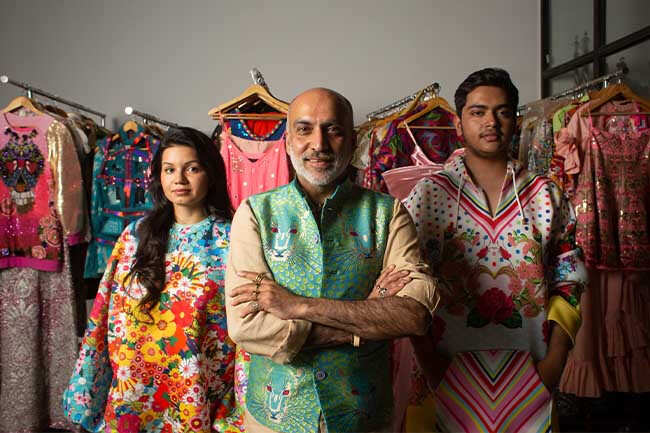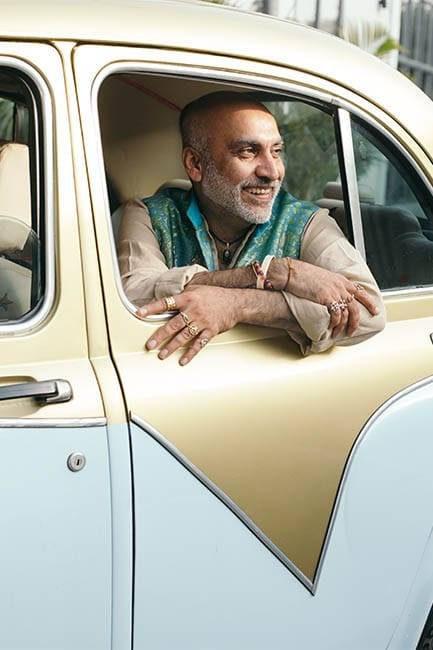THE OUTLIER
A true master of maximalism, Manish Arora has built a brand of acclaim that travels beyond borders. Many runway shows later, he talks about how his work will always be deeply rooted in the Indian craft
New Delhi’s Dhan Mill compound is where the cool kids are at. It’s where you’ll find coffee shops with lofty ceilings and rustic furniture, all straight out of a Pinterest board. It’s no surprise then that this space is also home to Manish Arora’s workshop, a chintzy studio full of stained-glass hearts, artwork and mirrors. The designer himself is dressed in a cacophony of colours as he steps out of his beloved gold Ambassador with a ring on every finger, and a wrist band that says ‘Naah, I’m good’. But we haven’t met him on a regular day – his workspace is chock-full with his most memorable looks from over the years, a curation for his 30th anniversary presentation at the Peabody Essex Museum in Salem, Massachusetts, which is set to take place in 2021. We catch glimpses of sequinned onesies in sapphire blue and poufy peach gowns encrusted with pearls.
It’s an understatement to say that Arora’s work is off kilter. Born and raised in Mumbai, the designer studied at the National Institute of Fashion Technology in New Delhi and then went on to launch his namesake label in 1997. His designs have always been larger than life – bursting with colour, wildlife motifs and psychedelia. In 2005, he made his debut at London Fashion Week, and has been a permanent fixture on the international runway calendar. His aesthetic is resolute – it’s layered, provocative and perhaps not for everyone. But that’s what further cements his ideology – he isn’t catering to the
plain Jane.
YOUNG, WILD AND FREE
“In the days that we started, the infrastructure and facilities were different. People were not aware of what was happening internationally. But there was more freedom to express what was going on in our mind, we could take risks, we could be more extravagant compared to businesses that are being launched by people today,” he says. We ask him about the first garment he ever made, “For one of the first collections I made I bought these kurtas in khadi and used appliqué on them. It was the in brightest pink, which is my identity. It had reflective flowers on it, so that part has stayed from then to now.”
The sheer conspicuousness of his designs prompts several observations about his work but, as always, the devil is in the details. His collections have always been deeply rooted in celebrating pride, self-love and spirituality – his models waft down resembling otherworldly creatures. It’s far from an ordinary experience.
“People often call my work kitschy, which it isn’t. Kitsch refers to design in poor taste, often from another time, thereby questioning its relevance. My work is much deeper than just the visuals of it. The techniques used are all ancient Indian techniques – like zardozi paired with very unusual materials and brocade, sourced from Benaras to Surat, has been a mainstay. These textiles and embroideries create visuals that are very modern. And sometimes, people who don’t know much about the technicalities about embroideries or textiles or surface embellishments may perceive it as kitsch. But I am far more than that. Being colourful and technique-oriented is what my work is about. Yes, it is over the top because I think more is less. For me, that’s very normal.”
From L-R:Garima Madan, head designer; Manish Arora, founder; Dhruv Bandil, designer
CULT OF COOL
While Arora wants his work to be recognised by a wider audience, he isn’t concerned about fitting in, and that’s probably what placed him on the world map, “My work is unique because it’s a combination of art and fashion. When the taste of a person is unique in terms of style, it’s possible to be relevant for a longer period of time than others, that happens only if you do something straight from your heart without getting diluted by other infuences around you. It is not easy, but it gives the brand a stronger identity. My work is recognised my friend’s children in a magazine and is also identified by somebody who is 80 years old. Working the international calendar has also kept my identity intact.”
If you sift through Arora’s designs, they come with a promise to made heads turn and grab eyeballs – whether it’s his quirky sweatshirt that says, ‘I am the one I’ve been waiting for’ in saccharine pink or a mini skirt with a chartreuse appliqué heart. Who does he think of as his ideal muse? “Wearability is a state of mind. What it is to me, may not be to someone else. My muse is someone who has a very strong dressing sense of their own, like Katy Perry. I like a person who is ready to stand out in a crowd, is not shy of being themselves, and doesn’t care about what other people think.”
Over the years, the designer has explored his skill set via diverse areas, resulting in several memorable collaborations. He’s teamed up with watch brand Swatch, skincare brand Kama Ayurveda on Valentine’s Day to launch the #LoveisLove Box in his signature fuchsia pink as well as jewellery label Amrapali, which offered everything from spikey ear-cuffs, enamel deer motifs and cupcake rings. And of course, there’s Fish Fry – a second brand launched by him almost two decades ago
that produced an athletic diffusion line with accessible price points, which also joined hands with Reebok for a line of quirky sneakers, “Even though we don’t work on Fish Fry anymore, it’s amazing how so many years later the brand still has incredible recall value and is mentioned many times in my conversations with people.”
WORLD STAGE
Arora was invited to showcase his collections on the international runways at a time when it was a rare privilege, and the process of breaking through was every bit daunting, “When I went to London for my debut, I had no stylist or PR agency, the hair and make-up was done by the same person. It was all about starting from ground zero. The advantage of being Indian at fashion week is that you can portray India in the way that you wanted to. The disadvantage was that there was nobody’s footsteps to follow in. I still remember the first time somebody told me that Kate Moss was wearing my creation on a magazine cover, and I didn’t even know who she was, but that’s the beauty of the business, you’re always evolving, always learning.”
NEW DAWN
As he spends his time between Paris and New Delhi, Arora feels that current times are all about turning over a new leaf, “We will move towards a more digitised world; devoid of physical connection, we will now come together like never before. People will also start investing in more homegrown brands, and will value designers and artists from India.”

